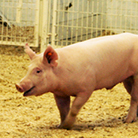Managing the risk of PEDv transmission through feed ingredients
Posted: February 19, 2015 | Written By: Simon Kern, M.S., Form-A-Feed Nutritional Services

The United States swine industry was brought to its knees in the fall and winter of 2013/2014 by porcine epidemic diarrhea virus (PEDV). PEDV quickly became a four letter word to many swine producers as an estimated 8 million piglets were lost during this time period.
While typical modes of disease transmission were certainly a factor, the idea that feed, porcine derived products especially, could be a route of transmission introduced due to the erratic spread of the virus. This proof of concept was later proven true in that the virus could survive and be spread through contaminated feed. The question of how substantial this risk was and how this risk compared to typical modes of transmission was left unanswered at the time.
The University of Minnesota and the National Pork Board recently released a report titled “Risk assessment of feed ingredients of porcine origin as vehicles for transmission of Porcine Epidemic Diarrhea Virus (PEDV)”. This study was conducted to evaluate and answer these questions. The report’s findings state the high heat and duration of rendering makes the risk of transmission negligible as this combination will inactivate the virus. However, the lower temperatures and exposure time involved with spray-drying makes products like blood meal a greater risk. Still, the probability of PEDV surviving the spray-drying process in conjunction with the post-processing storage is extremely small. The likelihood for post-processing contamination of finished ingredients through several pathways was also deemed negligible.
While these findings should be viewed as highly positive to those of us in the swine and swine feed industry, we at Form-A-Feed continue to manage our risks by taking additional steps to protect our customers. To reduce the risk of cross contamination in our mill, we eliminated porcine meat and bone meal as an available ingredient in early 2014. Additionally, all of our swine starter products, including Safe Choice and Starter Crumble 1000, are now free of any rendering derived ingredients. While this was an inconvenience at the time, this challenge has allowed us to discover better alternative ingredients which support baby pig health and performance while subsequently reducing our customers’ risk of PEDV exposure.